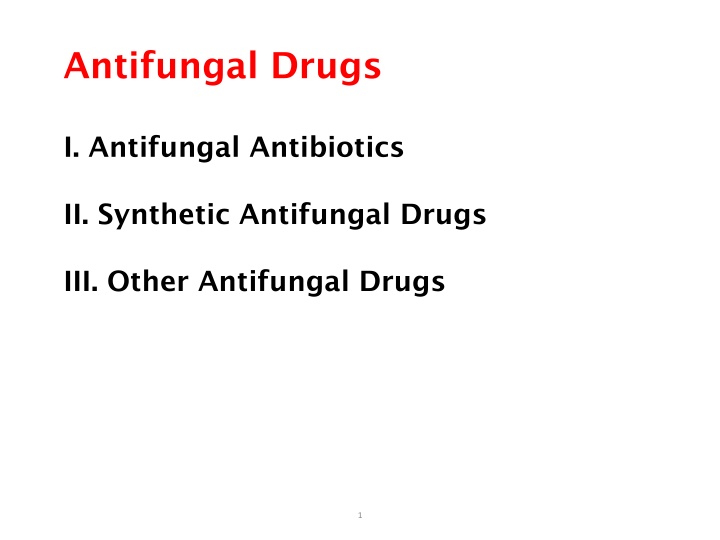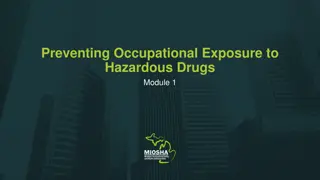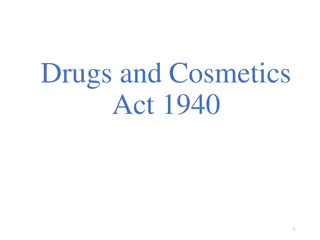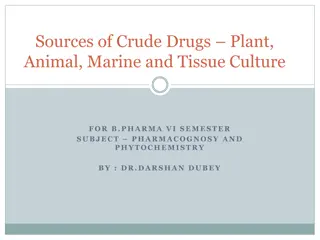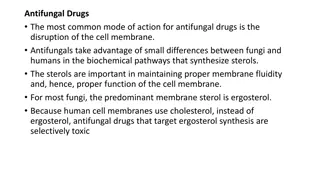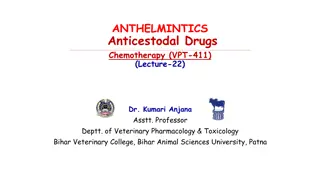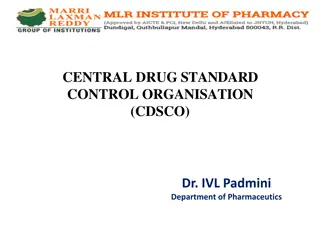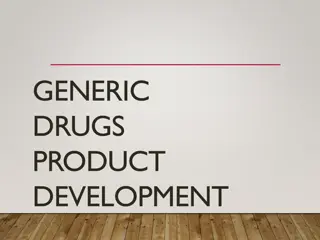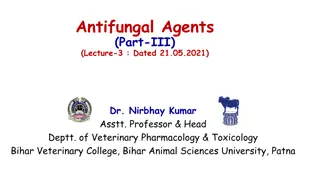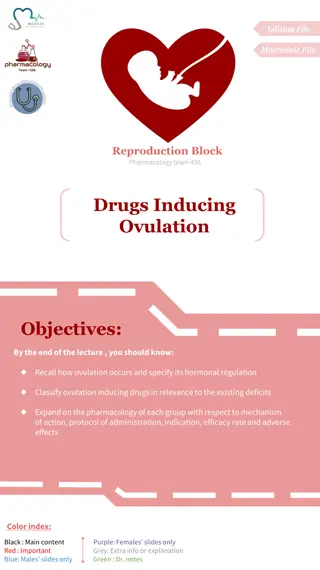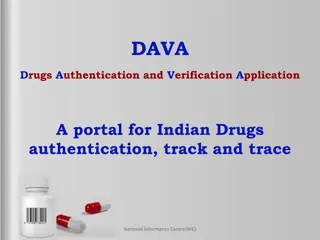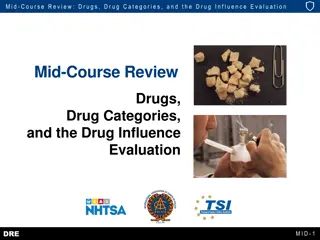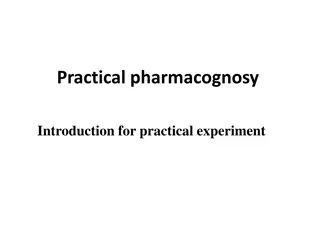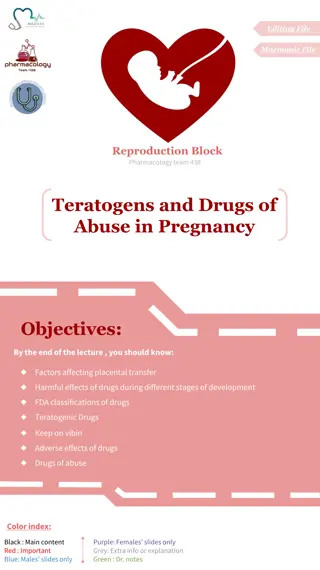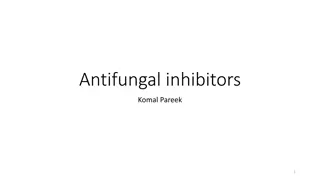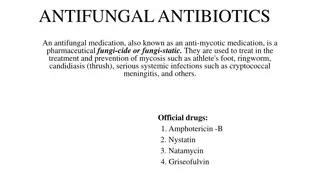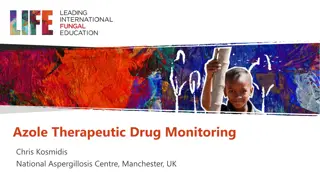Antifungal Drugs
Antifungal drugs play a crucial role in combating fungal infections. Learn about different types such as Amphotericin and Nystatin, their mechanisms of action, pharmacokinetic aspects, and potential side effects. Gain insights into the treatment of fungal infections with these medications.
Download Presentation

Please find below an Image/Link to download the presentation.
The content on the website is provided AS IS for your information and personal use only. It may not be sold, licensed, or shared on other websites without obtaining consent from the author.If you encounter any issues during the download, it is possible that the publisher has removed the file from their server.
You are allowed to download the files provided on this website for personal or commercial use, subject to the condition that they are used lawfully. All files are the property of their respective owners.
The content on the website is provided AS IS for your information and personal use only. It may not be sold, licensed, or shared on other websites without obtaining consent from the author.
E N D
Presentation Transcript
Antifungal Drugs I. Antifungal Antibiotics II. Synthetic Antifungal Drugs III. Other Antifungal Drugs 1
I. 1. Amphotericin (amphotericin B) Is a mixture of antifungal substances derived from cultures of Streptomyces. polyene macrolide. Antifungal antibiotics: Mechanism The site of amphotericin action is the fungal cell membranes, where it interferes with permeability and with transport functions. Forms large pores in the membrane. It creates a transmembrane ion channel, causing disturbances in ion balance including the loss of intracellular K+. Amphotericin has a selective action, binding avidly to the membranes of fungi and some protozoa, less avidly to mammalian cells and not at all to bacteria. The basis of this relative specificity is the drug s greater avidity for ergosterol, a fungal membrane sterol that is not found in animal cells (where cholesterol is the principal sterol). Amphotericin is active against most fungi and yeasts, and is the gold standard for treating disseminated infections caused by several organisms including Aspergillus and Candida. Amphotericin also enhances the antifungal effect of flucytosine (see below), providing a useful synergistic combination. 2
Pharmacokinetic aspects Poorly absorbed when given orally, and this route is used only for treating fungal infections of the upper gastrointestinal tract. It can be used topically For systemic infections given by slow IV injection complexed with liposomes or other lipid-containing preparations. This improves the pharmacokinetics and reduces the side effects. Highly protein bound. Poorly penetrates tissues and membranes (such as the blood brain barrier). Found in high concentrations in inflammatory exudates and may cross the blood brain barrier more readily when the meninges are inflamed. IV amphotericin is used with flucytosine to treat Cryptococcal meningitis. It is excreted very slowly via the kidney. Unwanted effects Renal toxicity 80%, hypokalaemia occurs in 25% of patients, hypomagnesaemia, anaemia , impaired hepatic function, reactions. Injection frequently results initially in chills, fever, tinnitus and headache, and about one in five patients vomits, thrombophlebitis is sometimes seen after IV. Intrathecal injections can cause neurotoxicity, and topical applications cause a skin rash. The (considerably more expensive) liposome-encapsulated and lipid-complexed preparations cause fewer adverse reactions. thrombocytopaenia and anaphylactic 4
2. Nystatin (fungicidin) A polyene macrolide antibiotic similar in structure to amphotericin and with the same mechanism of action. It is not absorbed through mucous membranes or skin. Use is mainly limited to Candida infections of the skin, mucous membranes and the gastrointestinal tract. Unwanted effects may include nausea, vomiting and diarrhoea. 3. Griseofulvin A narrow-spectrum antifungal agent isolated from cultures of Penicillium griseofulvum. It interferes with mitosis by binding to fungal microtubules. It can be used to treat dermatophyte infections of skin or nails when local treatment is ineffective, but treatment needs to be very prolonged. It has largely been superseded by other drugs. Pharmacokinetic aspects: given orally, absorption varies with the type of preparation, in particular with particle size. It is taken up selectively by newly formed skin and concentrated in the keratin. The plasma half-life is 24 h, but it is retained in the skin for much longer. It potently induces cytochrome P450 enzymes and causes several clinically important drug interactions. Unwanted effects: gastrointestinal upset, headache, photosensitivity, allergic reactions (rashes, fever). The drug should not be given to pregnant women. poorly soluble in water, and 5
4. Echinocandins Echinocandins comprise a ring of six amino acids linked to a lipophilic side- chain. All drugs in this group are based on the structure of echinocandin B, which is found naturally in Aspergillus nidulans. The echinocandins inhibit the synthesis of 1,3- -glucan, a glucose polymer that is necessary for maintaining the structure of fungal cell walls. In the absence of this polymer, fungal cells lose integrity and lyse. a) Caspofungin Is active in vitro against a wide variety of fungi. Proved effective in the treatment of candidiasis and invasive aspergillosis that are refractory to amphotericin. Oral absorption is poor, and it is given IV, once daily. b) Anidulafungin is used mainly for invasive candidiasis; given IV. The principal side effects of both drugs include nausea, vomiting and diarrhoea, and skin rash. c) Micafungin For treating invasive candidiasis. Unwanted effects are mild, and their incidence less than that seen with amphotericin. 6
II. Synthetic Antifungal Drugs Azoles The azoles are a group of synthetic fungistatic agents with a broad spectrum of activity based on: 1) Imidazole (clotrimazole, econazole, miconazole, tioconazole and sulconazole) or 2) Triazole nucleus (itraconazole, fluconazole). fenticonazole, ketoconazole, Posaconazole, voriconazole and Mechanism The azoles inhibit the fungal cytochrome P450 3A enzyme, lanosine 14 - demethylase, which is responsible for converting lanosterol ergosterol, the main sterol in the fungal cell membrane depletion of ergosterol alters the fluidity of the membrane and this interferes with the action of membrane- associated enzymes The net effect is an inhibition of replication. Azoles also inhibit the transformation of candidal yeast cells into hyphae the invasive and pathogenic form of the parasite. Depletion of membrane ergosterol reduces the binding of amphotericin. 1. Ketoconazole First azole that could be given orally to treat systemic fungal infections. It is effective against several different types of organism. Well absorbed from the GIT, distributed widely throughout the tissues and tissue fluids but does not reach therapeutic concentrations in the central nervous system unless high doses are given. Inactivated in the liver and excreted in bile and in urine. Its t1/2 in the plasma is 8 h. 7
Unwanted effects: liver toxicity, rare but can be fatal (liver function is monitored before and during treatment), GIT adrenocortical steroid and testosterone synthesis (gynaecomastia in some male patients). Drug interactions: Ciclosporin and astemizole all interfere with cytochrome P450 drug-metabolising enzymes, causing increased plasma concentrations of ketoconazole or the interacting drug or both. Rifampicin, histamine H2receptor antagonists and antacids decrease the absorption of ketoconazole. disturbances, pruritus, inhibition of 2. Fluconazole Well absorbed and can be given orally or IV. It reaches high concentrations in the cerebrospinal fluid and ocular fluids, and is used to treat most types of fungal meningitis. Fungicidal concentrations are also achieved in vaginal tissue, saliva, skin and nails. It has a t1/2of 25 h, and is mainly excreted unchanged in the urine. Unwanted effects: generally mild, include nausea, headache and abdominal pain, Stevens Johnson syndrome in AIDS patients, hepatitis. No inhibition of hepatic drug metabolism and of steroidogenesis that occurs with ketoconazole. 8
3. Itraconazole Active against a range of dermatophytes. It may be given orally but, after absorption (which is variable), undergoes extensive hepatic metabolism. It is highly lipid soluble (and water insoluble). Available in a special formulation for IV. Administered orally, its t1/2is about 36 h, and it is excreted in the urine. It does not penetrate the cerebrospinal fluid. Unwanted effects: hepatoxicity, Stevens Johnson syndrome, GIT disturbances, headache, allergic skin reactions. Inhibition of steroidogenesis has not been reported. Drug interactions as a result of inhibition of cytochrome P450 enzymes occur (similar to those described above for ketoconazole). 4. Miconazole Given topically for oral and other infections of the gastrointestinal tract. It has a short plasma t1/2and needs to be given every 8 h. It reaches therapeutic concentrations in bone, joints and lung tissue but not in the central nervous system, Inactivated in the liver. Unwanted effects: relatively infrequent, GIT disturbances, pruritus, blood dyscrasias, hyponatraemia, liver damage (not given to patients with impaired hepatic function). 9
5. Other azoles Clotrimazole, econazole, tioconazole and sulconazole are used only for topical application. Clotrimazole interferes with amino acid transport into the fungus by an action on the cell membrane. It is active against a wide range of fungi, including candidal organisms. These drugs are sometimes combined with anti-inflammatory glucocorticoids. Poscanazole and voriconazole are used mainly for the treatment of invasive life-threatening infections such as aspergillosis. III. Other Antifungal Drugs 1. Flucytosine Is a synthetic, orally active antifungal agent that is effective against a limited range (mainly yeasts) of systemic fungal infections. If given alone, drug resistance commonly arises during treatment, so it is usually combined with amphotericin for severe systemic infections such as candidiasis and cryptococcal meningitis. Mechanism: Converted to the antimetabolite 5-fluorouracil in fungal but not human cells. 5-Fluorouracil inhibits thymidylate synthetase and thus DNA synthesis. Usually given by IV infusion and orally. Widely distributed throughout the body fluids, including the cerebrospinal fluid, 90% excreted unchanged via the kidneys, and the plasma t1/2is 3 5 h. The dosage should be reduced if renal function is impaired. 10
Unwanted effects: are infrequent, gastrointestinal disturbances, anaemia, neutropenia, thrombocytopenia, alopecia (reversed when therapy is stopped), hepatitis (rare). Uracil is reported to decrease the toxic effects on the bone marrow without impairing the antimycotic action. Oral & IV 2. Terbinafine Highly lipophilic, keratinophilic fungicidal compound active against a wide range of skin pathogens. It is particularly useful against nail infections. Mechanism: selectively inhibiting the enzyme squalene epoxidase, which is involved in the synthesis of ergosterol from squalene in the fungal cell wall. The accumulation of squalene within the cell is toxic to the organism. When used to treat ringworm or fungal infections of the nails, it is given orally. The drug is rapidly absorbed and is taken up by skin, nails and adipose tissue. Given topically, it penetrates skin and mucous membranes. It is metabolised in the liver by the cytochrome P450 system, and the metabolites are excreted in the urine. Unwanted effects: gastrointestinal disturbances, rashes, pruritus, headache, dizziness, joint and muscle pains, rarely hepatitis. 3. Naftifine, butenafine are similar in action to terbinafine. 4. Amorolfine a morpholine derivative, interferes with fungal sterol synthesis, is available as a nail lacquer, being effective against onychomycoses. 11
5. Ciclopirox: inhibits the transport of essential elements in fungal cell, disruping the synthesis of DNA, RNA & protein. 1% shampoo for seborrhheic dermtitis. 6. Tolnaftate : tinea 12
